In western Nepal, I searched for blue poppies in Jumla and Simikot. Both regions are relatively unaffected by the monsoon and sunny days continued. But as the air route from Nepalgunj is using visual flight along valleys, flights are sometimes suspended when the valley is covered with clouds. We got stuck for two days in Jumla and five days in Simikot.
|
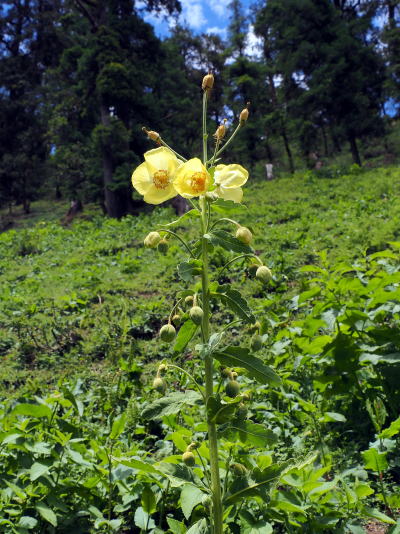 |
| |
Meconopsis paniculata subsp. pseudoregia |
| |
|
| |
We hired a 4WD at Jumla Airport and headed to Daphe Laguna Pass on the
way to Rara Lake National Park. Before arriving at the pass there are about
10 tall slender flowers stood on the slope. They are 1.2m tall and with
golden-yellow petals. It looks very similar to Meconopsis paniculata, which
is widely seen in the Himalayas, but the habitat is as far as central Nepal
– not here in the west. Looking closely, the stigma is yellowish green
and the leaves are coarsely toothed. As the stigma of paniculata is purplish-brown
and the leaves are pinnately incised, it turned out Meconpsis paniculata
subsp. pseudoregia. It looks similar to Moconopsis regia, but we will meet
it in Lamjung Himal later.
(Alt. 3450m/south of Daphe Laguna) |
| |
|
stigma |
leaf |
|
|
pseudoregia |
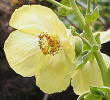 |
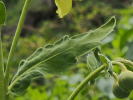 |
|
|
paniculata |
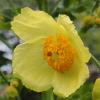 |
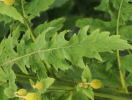 |
|
|
| Thirty-one years ago, in early August 1991, the late Toshio Yoshida completed
his trek in western Nepal by crossing this pass and headed for Lake Rara.
He might see this pseudoregia. |
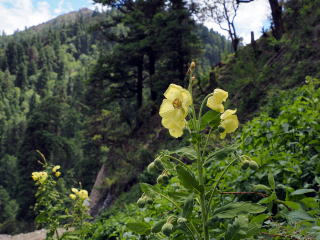 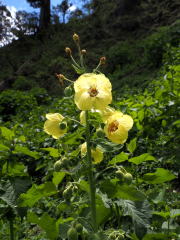 |
|
|
Meconopsis aff. grandis (subsp. jumlaensis?)
Arriving at Daphe Laguna Pass, we showed some photos of Jumlaensis taken in 2008 by Mr. Shuichi Noshiro, a botanical archaeologist, to nearby herders at the teahouse. They knew this flower and saw before, so we asked them to take us to the place. There were five to six plants were densely growing in the shade of a large rock on the bank of a stream down a steep slope from the road. Among them two had flowers and the rest had already turned into fruit. They said the flowers were early this year.
The flower is about 1 m tall, the corolla diameter is 10 cm, and the basal leaves are large, 20 cm long and 6 cm wide. Leaves and fruits are hairless.
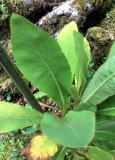 |
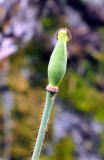 |
(North of Daphe Laguna: Alt. 3440m) |
| basal leaf |
fruit |
|
Here comes a question... this is too big. Is this M. jumlaesnsis? |
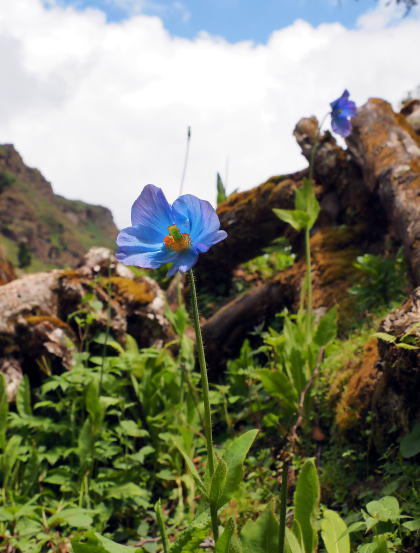 |
Gray-Wilson's blue poppy monogram "The Genus of Meconopsis" describes
that the length of jumlaesnsis is less than 35 cm, and the width of basal
leaves are narrow at 2.7 cm or less.
Now, what is this flower? The size is same to M. grandis, but it is different as the grandis’s basal leaves are narrower.
So far, I have been seen M. grandis in
Kanchenjunga and Topuke-gola in eastern Nepal and Kuanshun Valley in the east
of Mt. Everest in Tibet, but even the Kuanshun Valley it is more than 500 km away.
Moreover, between here and the valley no species close to Grandis to yet be
found. If this flower is not the subspecies jumlaesnsis, is it the grandis or
is a new variant?
|
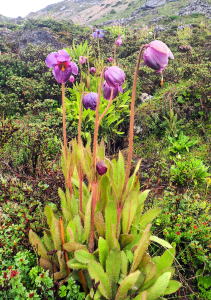 |
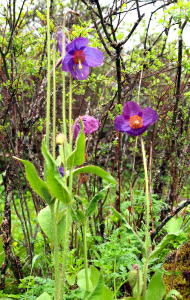 |
| (in Topkegora) |
(in Kuanshun Valley) |
|
After photographing, we went to the south slope of the pass where Mr. Noshiro
collected jumlaensis and looked for it. Unfortunately, we couldn't find
any flowering plants, but did find one young rosette that will bloom next
year. Judging from the shape and size of the leaves, it is close to jumlaensis
photographed by Mr. Noshiro.
the law of nature.
It seems that there may be two types of M. grandis around this mountain
pass. I need to come and check again.
By the way, just after I finished shooting the flower the herdsman who
guided us snapped the young fruit and put it in his mouth. I know that
goats eat blue poppy fruits, but this is the first time I've seen human
eats the blue poppy fruit..
|
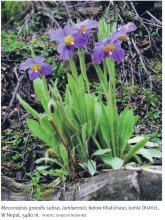 |
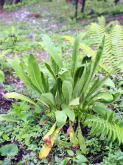 |
|
| (M. jumlaensis photographed by Mr. Noshiro /from "The Genus Moconopis" |
Young rosette near the site where Mr. Noshio collected. |
|
|
| Flowers seen around the pass |
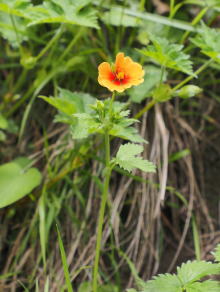 |
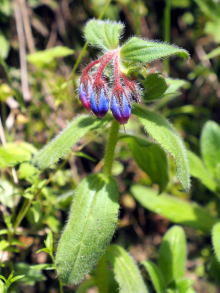 |
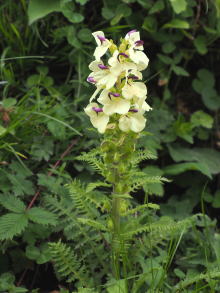 |
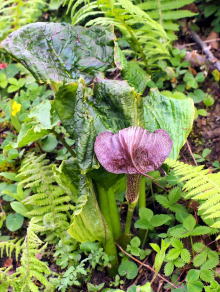 |
| Potentilla argyrophylla var. atrosanguinea (Rosaceae) |
Maharanga verruculosa
(Boraginaceae) |
Pediclarice klotzschii
(Scrophulariaceae) |
Arisaema griffithi
(Araceae) |
|
The heat that exceeded my body temperature and a raw salad made with Nepali’s
left hand in Nepalganj, and altitude change in Jumla made me serious sick
- severe diarrhea and a high fever of over 38 degrees Celsius. I suspected
that I was infected with the corona virus. Fortunately I could recovered
thanks to the delay of back-flight to Nepalganj. But still I had to drag
my heavy body to Simikot, the north-westernmost town.
|
Simikot airfield and townscape
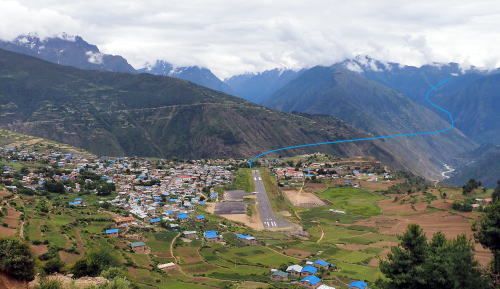 |
Simikot is the center of Humla District, at an altitude of 2900m. Access
to the outside world is only via cliffside roads and an air route from
Jumla. When the valley is buried in clouds, the flight will be cancelled.
Sometimes the flight will be suspended for about two weeks at the longest.
If that happens, meat disappears from hotel meals.
The runway is short at 500m, but since it locates on a plateau, it floats using the breeze from the valley and flies along the valley (blue line). Local airports in mountainous areas other than the main Kathmandu-Nepalganj line are built like this.
An open lot on the right side of the runway is to be used as a camp site for Hindus on their pilgrimage to Kailash. They fly from India to Simikot by helicopters and worship at a holy site near the border towards Mount Kailash. |
|
|
Meconopsis simikotensis
We climbed a mountain behind Simikot. Closing to the summit, it becomes a rocky mountain. There are simikotensis with many buds around its stem in a windbreak patch under the rocky cliff. Its figure is like the Greek goddess "Artemis of Ephesus" of fertility with many breasts.
The flowers that bloom in the mountains of the Kailash Highway are dotted along the road to the border, serving as signposts to guide pilgrims to Kailash.
(Altitude 3850m)
|
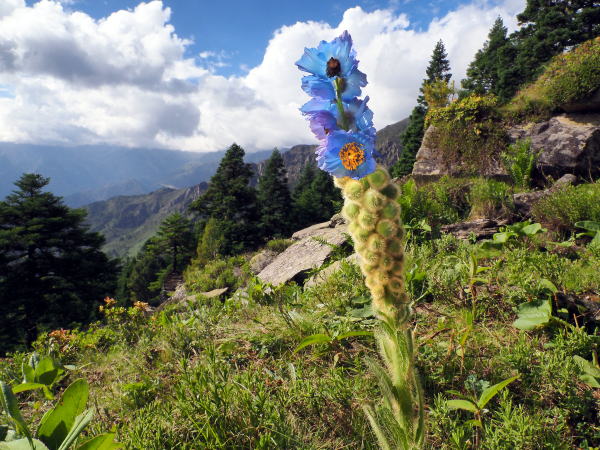 |
|
|
M. simikotensis |
M. simikotensis is classified in the subgenus discogyne within the Meconopsis
genus. A feature of this subgenus is that the head (style) of the fruit
spreads in a disc shape. Included in this subgenus are M. discigera and
M. pinnatifolia from Nepal, M. bhutanica from Bhutan, and M. torquata and
M. tibetica from Tibet.
|
|
|
|
|
| M. discigera |
M. pinnatifolia |
M. bhutanica |
M. torquata |
|
|
M. tibetica |
|
Shape of fruit |
|
|
Mr. Noshiro, mentioned above, saw this flower in 2008. A photograph of the occasion, published in Gray Wilson's “The Genus of Meconopsis” shows a local guide holding a simikotensis. It must have been brought back out of kindness for a client who could not come to its natural habitat. This is not desirable for endangered species protection.
Same thing happened this time. In the afternoon of the day we arrived at Simikot, we headed to the habitat guided by a hotel employee who knew the place. The employee and Mr. L could arrive there, but I was exhausted and rested in the pasture on the way because my physical condition had not recovered. In the evening, the employee came back with a splendid M. simikotensis as long as 1 meter in his hand. After measuring it, he buried it in the shade of a nearby rock, but when I climbed up again two days later, it had been eaten by goat. So, I failed to photograph this flower in its original form.
We were to return to Kathmandu the next day, but fortunately (!) there
were no flights for five days, so I could get there again and attain to
the place. The photo of the flower was taken at that time.
|
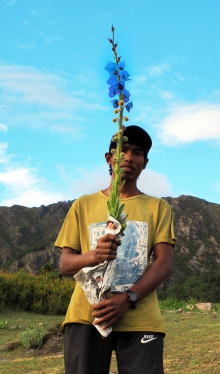 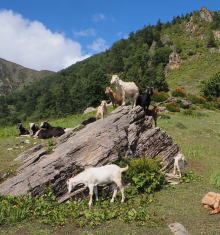 |
|
We could find a natural habitat of simikotensis based on Mr. Noshiro's
records in 2008. In addition, Mr. L climbed the near-by mountains and found
another natural habitat. A monk from Yalbang Gompa showed me a picture
of simikotensis blooming on the mountain behind the Gompa on his smartphone.
There also are other blue poppies such as M. robusta and M. chankeliensis,
which are yet seen in this region. For avoiding the weather influence,
I would like to explore this area by land with 4WD someday. New blue poppies
might be found.
|
After shooting these flowers I asked my guide to look for another one around. He found a tiny blue poppy in the gap of the rock ledge of the back cliff. Approaching to the place you must go on the narrow ledge with 30 cm wide and 30 m high from the bottom. If you miss your step, you will fall 30m (My sunglasses hit the rock and fell instead of me.)
Carefully closing to the point I found a blue poppy like M. horridula. But this has
1. some flowers on one stem (Raceme)
2. leaf edge notched or sinuated
So, it may not a type species of M. horridula, but may be a subspecies or variety of horridula, as its habitat extends from Qinghai province of China to western tip of Nepal.
Meconopsis aff.
horridula |
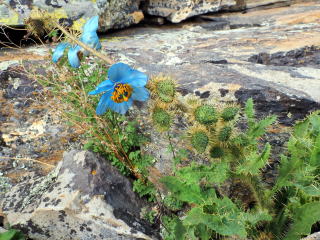 |
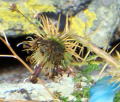 (fruit) (fruit)

(leaf) |
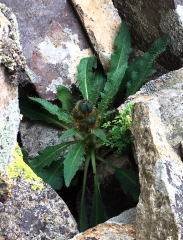 |
|
|
| Flowers seen in Simikot |
|
|
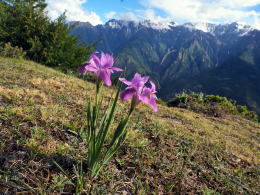 |
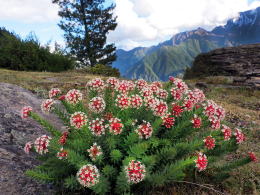 |
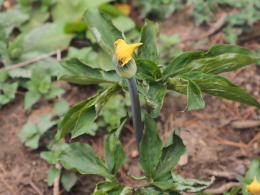 |
| Iris decora (Iridaceae) |
Stellera chamaejasme (Thymelaeaceae) |
Arisaema flavum (Araceae) |
Many leguminous flowers can be seen as western Nepal is rather dry. |
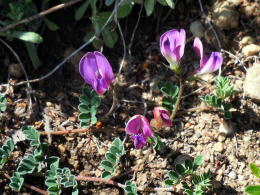 |
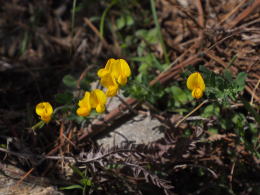 |
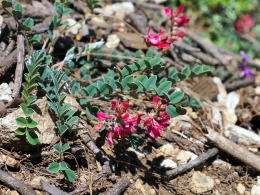 |
| Astragalus oxyodon |
Spongiocarpella purpurea |
Hedysarum kumaonense |
|
| |
 |
Lamjung Himal is located at the east end of the Annapurna range, facing the Manaslu range across the Marsyangdi River. The highest peak is Lamjung Kailash, which is 6983m above sea level and was first climbed by the British expedition in 1974. Although it is a good trekking course as an observatory of Manaslu, there are less trekkers to visit because of no lodgings along the way and steep ascending. So, it is mostly used by local herders. Also, few botanists have entered and studied this area, so the vegetation is not well known.
In 2013, looking for M. lamjungensis and M. gracilipes, Shun Umezawa took
a course that started from Siklis in the west, crossed east, and descended
to Bhulbhule. He couldn't find the two species, but he found a colony of
a large yellow poppy, Meconopsis regia. Based on his record, I took a course
that goes from north to south for the purpose to minimize the impact of
landslides caused by heavy monsoon rains. The trekking started from Timang
in the north. The road from Besisahar to Timang became impassable due to
a landslide during the trek. Our route selection was correct.
|
 |
We ascended through a dense moss-covered cloud forest. Orchids and flowers
preferring moist soothed our tiredness of long ascend. As we approached
the forest line, the first blue poppies appeared, and arrived at a campsite
Danfe Danda (altitude 3,900m) amid a colony of primrose. It started to
rain in afternoon, but fortunately leeches did not appear. |
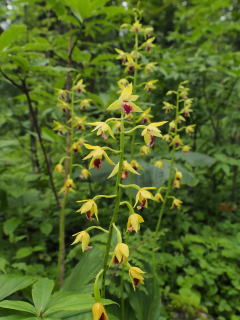 |
← Calanthe tricarnata |
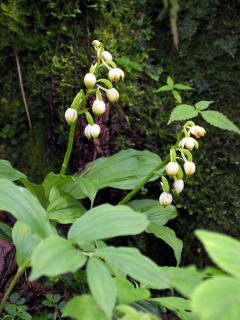 |
Both are orchidaceae and often seen in the Himalayas. The same or similar
species can be seen in Japan as well. |
Calanthe alpina →
|
| |
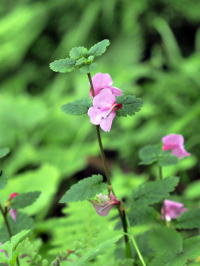 |
Pedicularis sp.
(Scrophulariaceae)
It bears pink flowers horizontally. This species is usually found in grasslands above the forest line. I saw this for the first time.
(Alt. 2940m) |
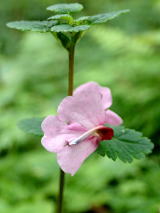
(enlarging flower) |
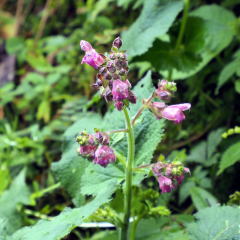 |
Salvia hians
(Lamiaceae)
There is species like this in Japan, but the flower is yellow. |
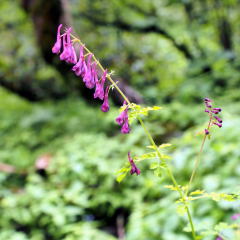 |
Corydalis sp.
(Papaveraceae) |
|
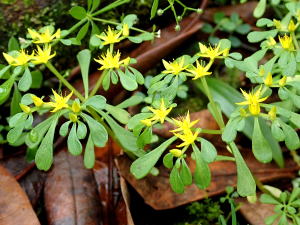 |
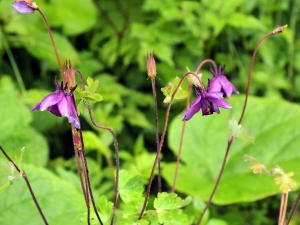 |
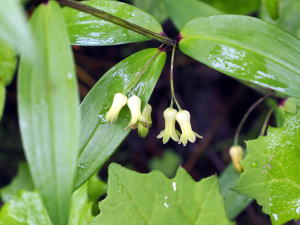 |
| Sedum sp. |
Aquigilea sp. |
Polygonatum sp. |
| |
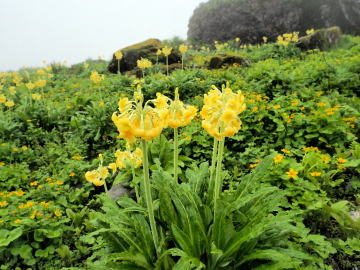 |
Primula stuartii
(Primulaceae)
Filling the campsite with full blooming flowers together with Caltha.
(at Danfe Danda: alt. 3900m) |
|
next to the stream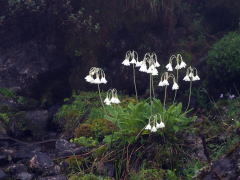
Primula obliqua |
I have been walking around Nepal several times, but this was unknown for me. I saw it for the first time and I couldn't even imagine a family name.
But Professor Ikeda of The University of Tokyo taught me the name.
Bistorta amplexicaulis (Polygonaceae)
(around 3000m above sea level) |
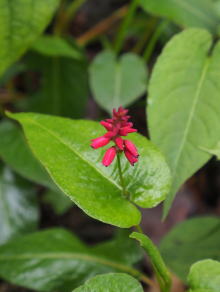 |
|
|
|
Overnight into the following morning it is a perfect clear sky. Kang Guru
(6,981m) to Nemjun (7,140m) and Pambari Himal (6,778m), which the Japan
Alpine Club Youth Corps made the first ascent and to Larkue (6,249m), the
avant-garde peak of Manaslu, line up in rows above the sea of clouds. They
are truly the pedestals of gods. |
 |
There is a steep but well-maintained stone stairway leading to Namun Pass. Both sides of the road are flower gardens.
Here comes a blue poppy! |
Meconopsis simplicifolia
|
It gets this name because the leaves are simple with smooth edges, but
this species in central Nepal has slightly sinuated edges or coarse serrations.
(leaf)
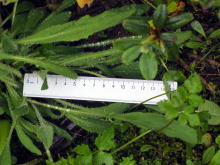
(Alt. 3950m) |
|
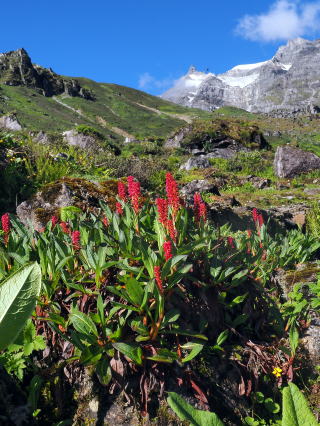 |
Bistolta affinis (Polygonaceae)
Forming large colonies on both sides of the trek road leading to the pass,
it looks like a red carpet laid. The sky is blue, the snow is white, and
the flowers are red, creating a very colorful landscape.
|
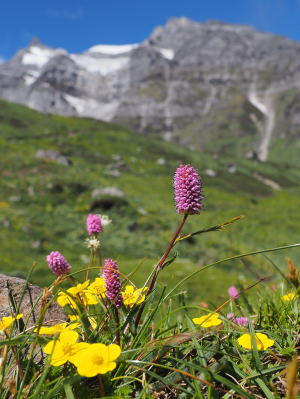
Bistorta macrophylla (Polygonaceae)
|
|
|
|
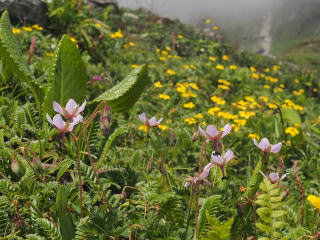 |
←Geranium refractum(Geraniaceae)
The petals are warped back and the stigma pops out. It shows the higher
presence to insects which convey pollens.
|
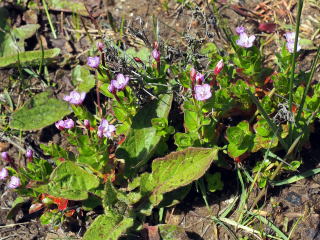 |
Epilobium wallichianum→
(Onagraceae)
A pioneer plant that spreads first in the avalanche trails. |
| |
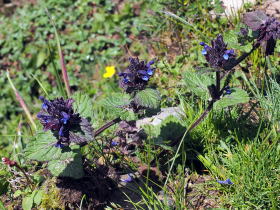 |
Nepeta lamiopsisi (Lamiaceae) |
After passing the first pass (Danfe pass: altitude 4280m), yak pastures
spread out below. Yaks seen like sesame seed are relaxingly eating grass.
The surrounding landscape changes to rocky and desolate one, and beyond
that lies the highest point of the route, Namun Pass.
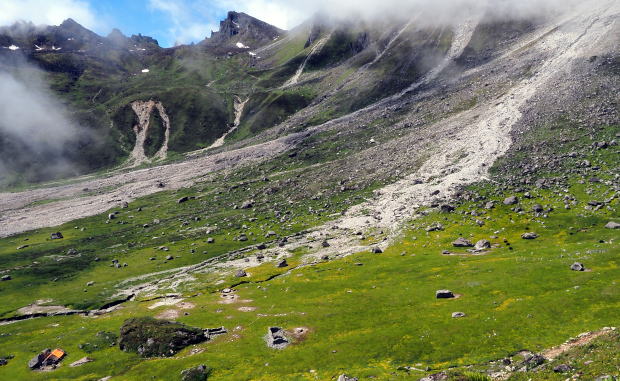 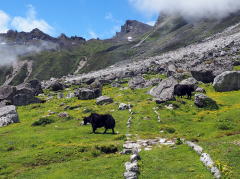 |
As the altitude increases the growing environment becomes harsher, and
the vegetation also changes. Cold-tolerant species such as primrose and
mat-growing plants are appearing. |
|
| |
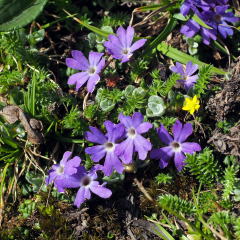 |
Primula tenuiloba (Primulaceae)
(Alt. 4680m) |
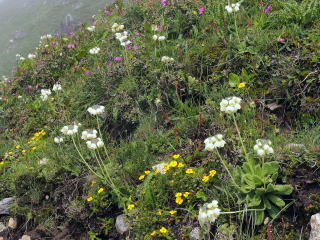 |
← Primula aff. wallichiana
P. wallichiana has purple petals. |
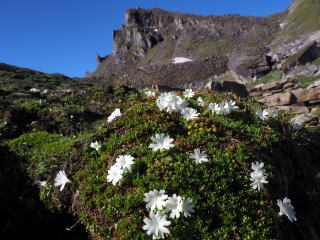 |
Primula sp.
Flowers are pushing
each other to avoid freezing. |
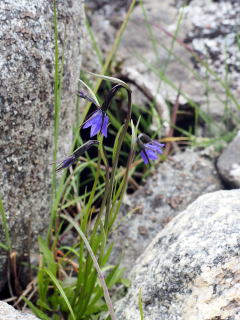 |
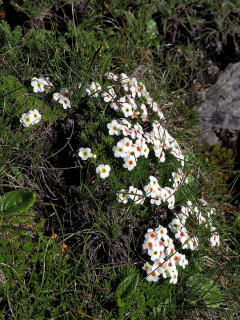 |
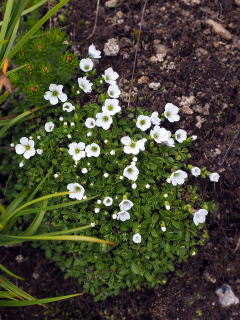 |
Adenopholia himaralayan
(Pantylaceae) |
Andorosace robusta
(Primulaceae) |
Gypsophila cerastioides
(Caryophyllaceae) |
|
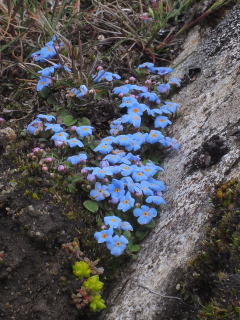 |
←Torigonotis rotumdifolia (Boraginaceae)
A member of Japanese cucumber herb (Trigonotis peduncularis). Smelling cucumber scent when rubbing leaves.
|
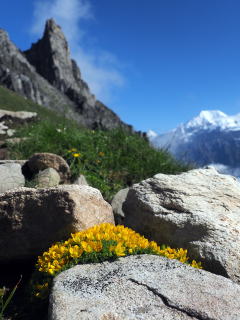 |
Saxifraga caveana →
(Saxifragaceae)
Saxifraga grows red runners to survive in rocky areas with little water.

|
|
| Highlands are rather dry due to low air pressure. Only succulents that
can store water in their leaves can survive. |
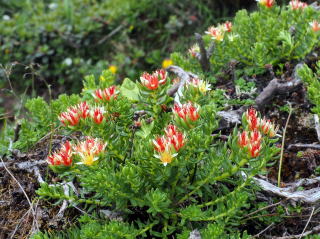 |
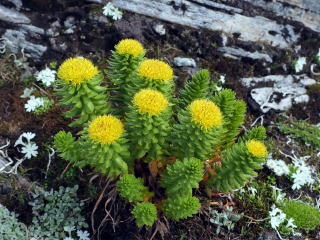 |
|
| |
Rhodeola crenitii (male)
(Crassulaceae) |
Rhodeola cimbricata(male)
(Crassulaceae) |
|
|
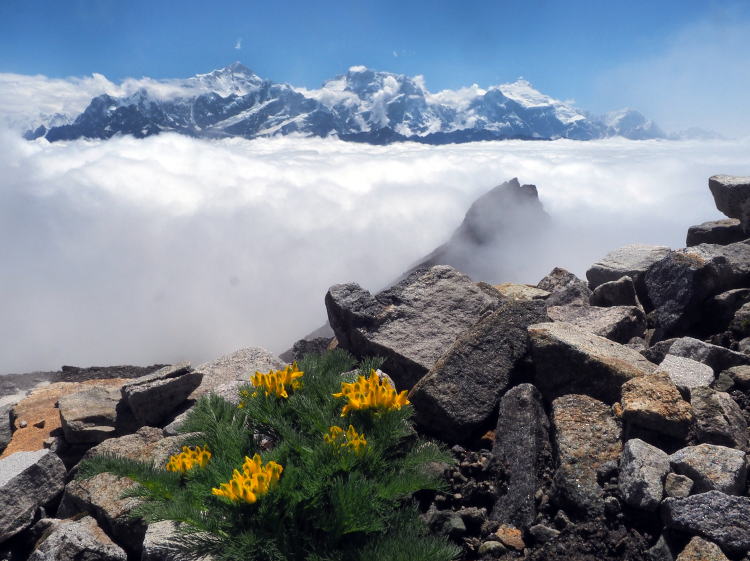 |
Corydalis govaniana Papaveraceae) The mountains behind are Manaslu, P29 and Himalchuli from
left to right.
(Altitude: 4830m) |
| |
Arrived at Namun Pass at the altitude of 4850m.
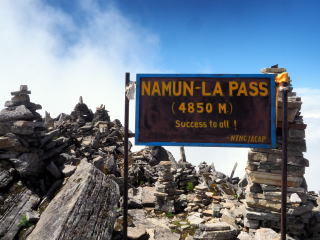
|
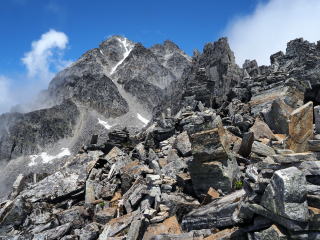
rocky mountain on the mountain pass |
What is waiting for us is .... |
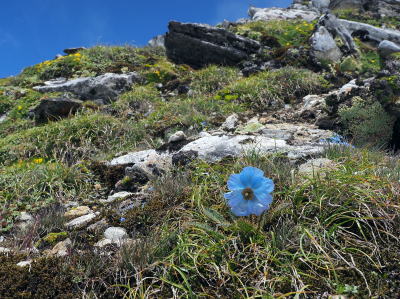 |
Meconopsis horridula
(Papaveraceae)
A typical blue poppy, the type subspecies has one flower on one stem (scapose).
Compare it with a species similar to M. horridula in Simikot
 (Enlarge by click) (Enlarge by click)
(Alt. 4890m) |
From the pass, we went down a steep, crunchy slope with broken granite. It often rains in the afternoon, but luckily it didn't rain until the evening, so we could pass through the difficult areas. After descending 800m at a stretch, there is a grassland where yaks are grazing. A large Meconopsis with yellow flowers like paniculata appeared near the big rock. Looking at the leaves...there are no notches.
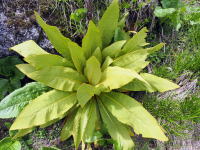 (basal leaves) (basal leaves)
|
Meconopsis regia
(Papaveraceae)
It is about 1m to 1.2m tall and the face size (flower diameter) is about 10cm wide. She is a well-proportioned beauty with 10-head in the Meconopsis world.
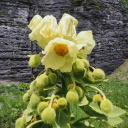
(Alt. 4140m)
|
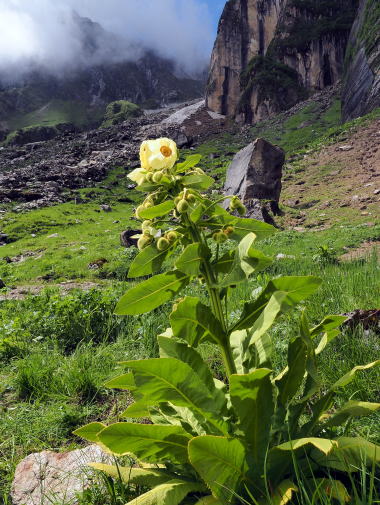 |
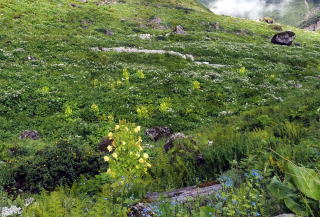
(Colony in the lower stream)
It is distributed along the flowing stream including subsoil water.
The differences from M. paniculata are
•Slightly smaller than paniculata
•No cuts in leaves
•Stigma of pistil is yellowish green (paniculata is purplish brown)
|
Other flowers observed during the crossing of the Pass |
|
|
Ponerochis aff. qusua
(Orchidaceae)
No side petals seen on the flower. Another species?
(Alt. 4110m) |
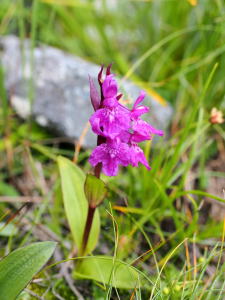 |
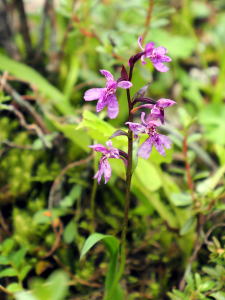 |
Ponerochis qusua
(Orchidaceae)
This flower is seen between Thorchu and Safrung where the altitude is 800m below. It has side petals.
(Alt. 3330m) |
Anemone rupicola
(Ranunculaceae)
|
Stem is short. The white sepals look like petals. Many of ranunculaceae
do not have petals or have inconspicuous petals.
(Altitude: 4470m) |
|
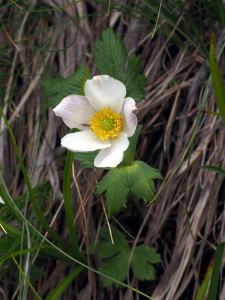 |
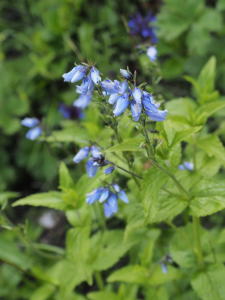 |
Veronica himalensis
( Scrophulariaceae)
(Altitude: 4120m)
|
Looking back at the Namun Pass we have crossed. |
|
|
|
 |
| Thorchu is the largest pasture on the course. Herders commissioned by several
yak owners graze the yaks during the summer. Aside grazing, they are also
moonlighting to collect Cordyceps Sinensis. When we showed a picture of
a species resembling Lamjungensis to a herder he said he once saw the flower,
so we took him as our guide. |
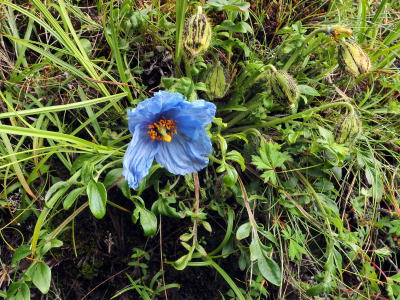 |
Meconopsis bella
(Papaveraceae)
M. bella usually grows halfway up the cliff. So it is hard to take pictures. This time with help of our guide I could manage to take.
(Alt. 4280m) |
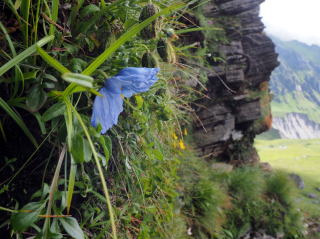 |
|
After crossing the last pass, where there is no ascent from now on...again appears |
|
M. horridula
The same species that I saw at Namun Pass.
(Alt. 4380m) |
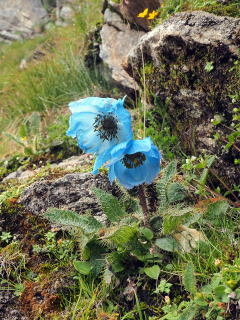 |
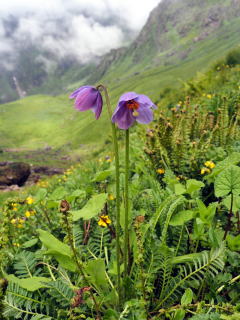 |
M. simplicifolia
Outstanding beautiful sisters among the simplicifolia met during this trek.
(標高:4250m) |
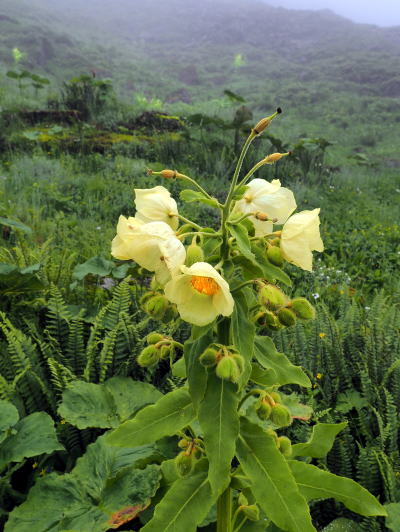 |
M. regia
Can be seen as spots in the fog. There is a stream in the middle of the
slope.
(Altitude: 3810m) |
|
|
Five or six meconopsis, taller than two meters long, stood on the site where the earth and sand had flowed. I thought it was M. paniculata because the leaves have notches, but the stigma is yellowish green. It resembles the subspecies of M. paniculata posted at the top of this website, M. pseudoregia, but here Lamjung Himal is out of the pseudoregia habitat. Its overall figure is close to paniculata. It may be emerging a new hybrid species |
If I dare to name it...
(tentatively naming as)
Meconopsis regia subsp. pseudopaniculata
(leaf)
(click to enlarge) 
(Altitude: 3680m) |
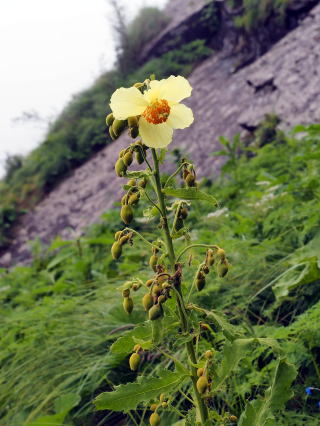 |
|
We were descending towards Safrung, the campsite for the day. A talkie
started ringing just after I had got over the collapsed land. It was from
Mr. L, who was walking slowly at the end of the trek line due to falling
ill just before starting the trek. He said that he had found a rare Meconopsis.
I was tired because of just passing the difficult part, so I replied, "I'll
see your picture later." But something began alarming in my mind.
So, I got off my backpack on the roadside and urgently returned about 300
meters back. Mr. L was sitting on the side of the road and pointing at
the bushes beside him. There was something at the tip of his finger. |
A small flower about 15 cm tall with pale blue-purple flowers about 1cm
wide. Watching closely inside the flower, there is a pistil with a protruding
style and a stamen with yellow pollen which has the same flower structure
of Meconopsis.
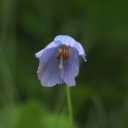
|
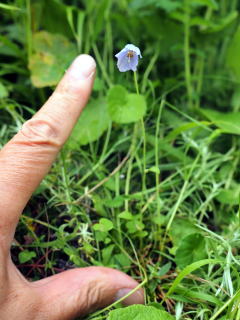 |
 |
The stems are sparsely hairy. No leaves can be seen at the base of the
stem, but one cauline leaf protrudes from the middle. (Inside the yellow
circle in the right photo. Click to enlarge)
It is very similar to Meconopsis bulbilifera, which was discovered in the
1994 Ganesh Himal expedition conducted by the University of Tokyo's Botanical
Department and reported as a new species. As the place we found is about
80km from Ganesh Himal in a straight line, it seems to be included in the
same habitat of M. bulbilifera.
|
| |
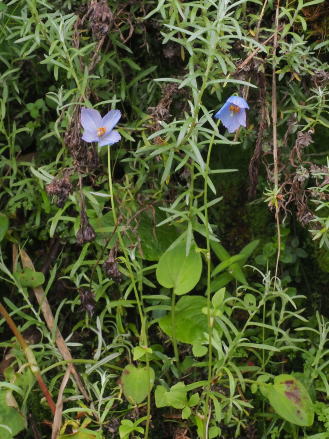 |
Meconopsis aff. bulibilifera
(Papaveraceae)
3These were blooming in another place nearby about 30m away from the above
one. They are about 20cm tall. There are two to three cauline leaves attached.
Under the request for identification to the University of Tokyo Botanical Department.
(Altitude: 3670m)
|
|
| The most common Meconopsis in the southern Himalayas is M. paniculata,
and Annapurna -Lamjung Himal is at the western edge of its distribution.
So to speak, it is a frontier. In botanical border, hybrids with other
species and special figures are often seen. I met such kind of paniculata. |
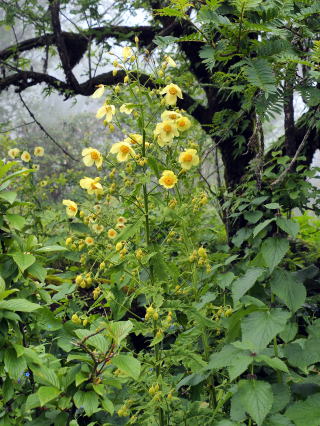 |
Meconopsis paniculata
(Papaveraceae)
It's a normal paniculata, but what's different is its height. In the above-mentioned
Gray-Wilson's "The Genus Meconopsis" it describes "The length
can be up to 2.5m, but usually 1~1.5m”, but this was over 3m. It may be
the largest Meconopsis paniculata ever recorded.
Even connecting two 1.3m long trekking poles did not reach the top. (Right
figure)
(Altitude: 3530m)
|
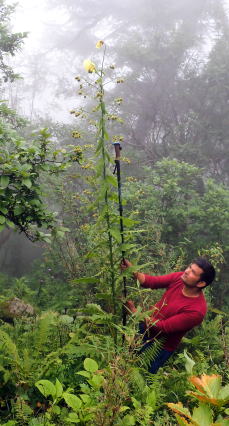 |
|
Lamjung Himal, where the smallest Meconopsis and the largest one coexist,
is rich in vegetation and deserves more attention.
Unfortunately, we could not find M. Lamjungensis and M. gracilipes (which
may have already disappeared from this area), but I have seen 6 species
of Meconopsis. Two of them were new ones to me. This all owes Mr. L who
has a sharp observational eye like a hawk. I would like to thank him. |
The road down from Thorchu was so plenty of Meconopsis that it could be called the 'Blue Poppy Road', but there were many other flowers that stopped me. |
Ful blooming in the grassland
(Altitude: 4340m) |
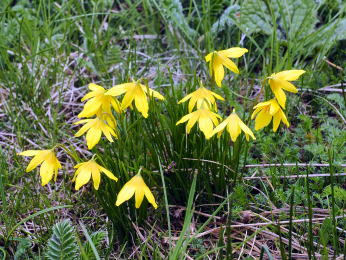 |
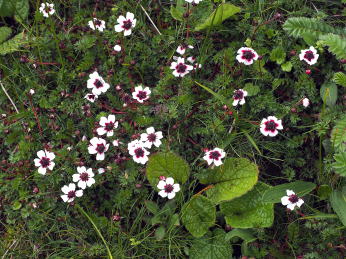 |
|
Lloydia flavonutans (Liliaceae) |
Potentilla coriandrifolia (Rosaceae) |
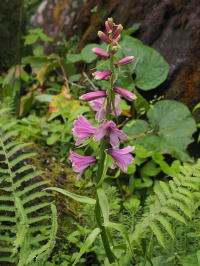 |
← Notholirion bulbuliferum (Liliaceae)
This grows over one meter tall.
(Altitude: 3540m) |
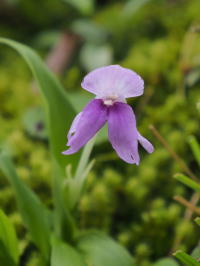 (Altitude: 3330m) (Altitude: 3330m) |
Roscoea alpina →
(Zingiberaceae)
Although this looks like an orchid,
it is a member of ginger. |
|
|
| There are many flowers that are seen in Japanese mountains, which makes
us to feel the continuity between Japan and the Himalayas. |
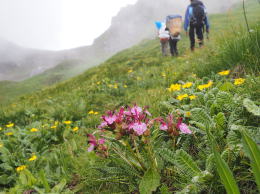 |
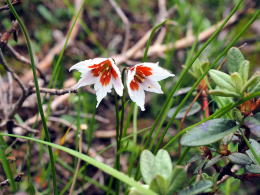 |
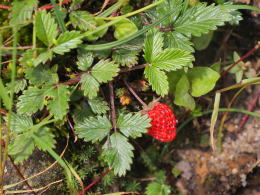 |
Pedicularis wallichii
(Scrophulariaceae)
Close to P. chamissonis
var. longirostrata in Japan |
Lloydia longiscapa
(Liliaceae)
Close to L. serotina in Japan |
Fragaria daltoniana
(Rosaceae)
Resembling Japanese grass strawberry.
Tasted delicious. |
|
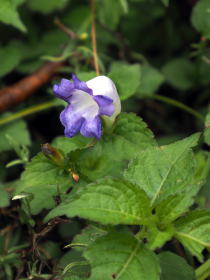 |
←Strobilanthes wallichii
(Acanthaceae)
Close to Strobilanthes japonica
(Altitude: 3580m) |
.jpg) (Altitude: 3700m) (Altitude: 3700m) |
Synurus sp. →
(Asteraceae)
Resembling S. pungens in Japan |
|
I didn't encounter any wild animals during the trek, but I did see some
traces. Never the creatures I want to meet though...
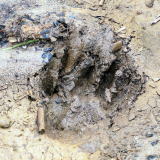 Indian leopard footprints. About 10 cm wide. Indian leopard footprints. About 10 cm wide. 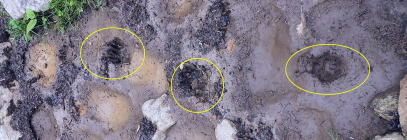
(Altitude: 3240m) |
The flower trekking ends at Safrung. In the evening, the three peaks of
Manaslu mountains emerged in the sky when the fog cleared slightly, and
were dyed red by the setting sun. They seem to say "Good-bye" |
 |
On the last day of trekking, it rained heavily from the morning. Leeches
sprang up from the earth. We hurried down the mountain with our porters
and arrived at Ghale Gaun, the final destination of the trek in the noon.
We finished trekking safely.
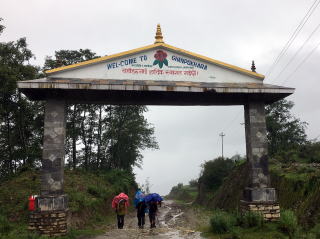 |
|























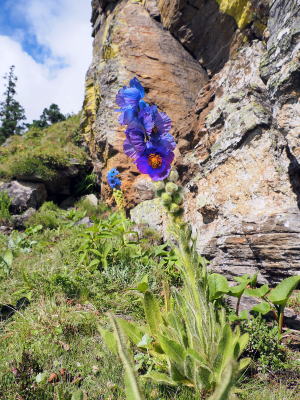
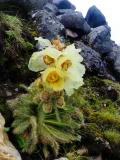
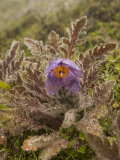
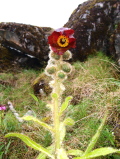
_thumb.jpg)



 (fruit)
(fruit)






















_thumb.jpg)
_thumb.jpg)
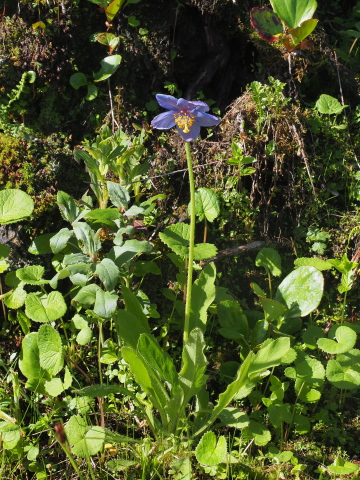


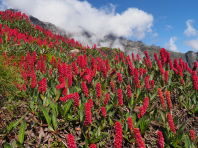

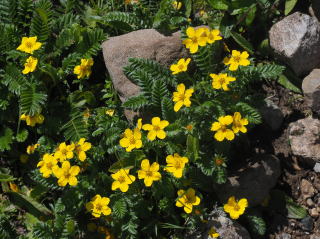
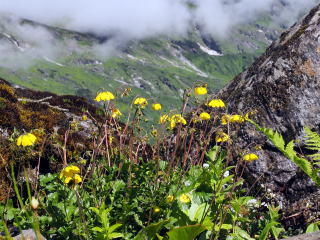
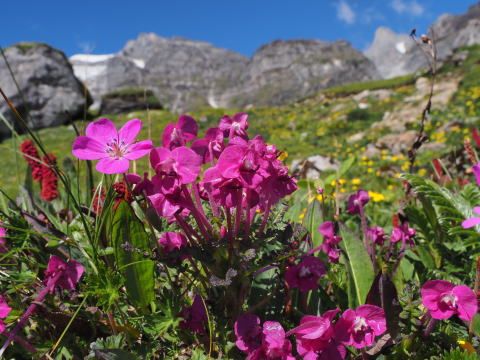

_thumb.jpg)
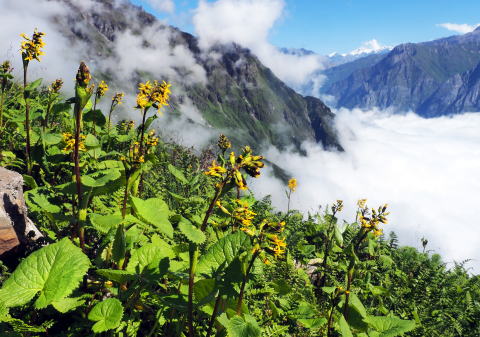 A
A




















 (basal leaves)
(basal leaves)
























 (Altitude: 3330m)
(Altitude: 3330m)



.jpg) (Altitude: 3700m)
(Altitude: 3700m)  Indian leopard footprints. About 10 cm wide.
Indian leopard footprints. About 10 cm wide. 

